Travel in Thailand Isaan
Isaan, the Thai name for the northeast region of the country and home to around 20 million folks, happens to be the most traditional but also poorest part of the country.
Not too many Western tourists make it up into Isaan and it is hard to argue with those people that do not go there, for there are not too many "must sees" in that part of the country – especially when you consider that there is a distinct lack of Westerner friendly tourist infrastructure, unlike the capital, Chiang Mai and the beaches and islands of the south.
Many tourists choose Thailand for the sun and sea and the shopping, none of which are prevalent in the Isaan region. While many people believe Chiang Mai to be the second largest city in Thailand, it isn't and that title actually belongs to the city of Korat, which is also known as "the gateway to Isaan" as it is the first province in the Isaan region that you reach if you're travelling from Bangkok. Unremarkable in appearance, Isaan is a predominantly agricultural part of the country.
What Isaan does offer to visitors to Thailand is a chance to get a glimpse at a more traditional way of life and it is my experience that people who feel a true affinity towards Thailand and the Thais thoroughly enjoy their time travelling throughout Isaan.
Should you mention to any Thai friends that you intend to travel into the Isaan region, you'll sure get a smile, or even a comment or two, for many Thais from outside the region have never been there – and many simply wouldn't be able to comprehend why a Westerner would want to go there for fun. Unfortunately the people of Isaan are looked down on by much of the Thai population who often view them as no more than poor farmers.
Isaan has the reputation of being very hot, something which I have never really understood. I have travelled throughout Isaan many times and have spent a lot of time in Korat. I have always found Isaan to be a bit cooler than Bangkok and certainly cooler than the central regions and the south. You seem to get more sunshine in Isaan than in other places and for sure there are less public facilities with air-conditioning, but as for the region being the hottest part of the country, well, I think I would actually dispute that. Anyway, don't be put off by people saying it is extremely hot as I have never found the heat to be too much, and yes, I have done a lot of travelling in the region in the hot season.
If you decide to travel into the Isaan region, and travel overland, be it car, train or bus, there are two major routes. The first and most popular route is to follow highway 2 from Bangkok all the way up to Nongkhai. This road passes through the major cities of Korat, Khon Kaen, Udon Thani and on to Nongkhai. This was the route of my first venture into Isaan and I have done this route a number of times. It is fun, and easy, but really there is not a lot to see or do with a few exceptions.
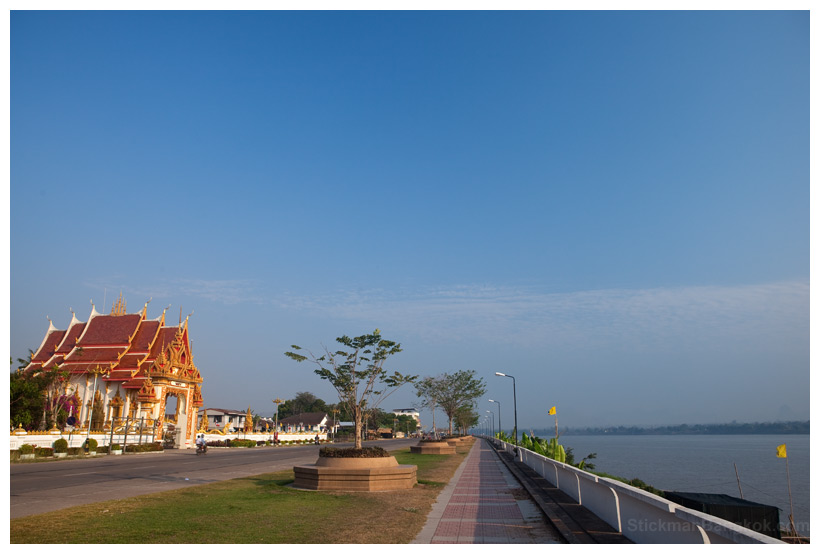
Nakhon Phanom in Isaan sits on the banks of the Mekong River with Laos opposite.
My preferred part of Isaan to tour through is the southern section. From Bangkok, go up to Korat and from there head east through Buriram, Surin, Si Saket and Ubon Rachathani. With the exception of Ubon, the 3 other provincial capitals are fairly small and frankly, not too interesting to the casual tourist. There aren't too many reasons to stay in these places. So why go this route? Well, assuming you go by bus or train, the scenery is a lot nicer in this part of the country and you get a lot more of the beautiful green rice paddies than you do if you head up to Nongkhai, especially at the end of the rainy season. Secondly, and of much more importance, is that there are some really nice ruins to see in this part of the country. The lower Isaan region is home to many old Khmer style temple complexes and to me, these are a lot more interesting than places like Ayuthaya. The Khmer ruins at Phimai in Korat province and Phanom Rung in southern Buriram are two of my favourite attractions in Thailand, both in excellent condition. Phanom Rung is especially good since not so many foreigners make it there and it is not over touristed like so many spots in Thailand are. In fact all throughout the southern part of Isaan you will find various temple ruins, some of which are merely a small pile of stones, but some of which are a whole lot more. In my Stickman Weekly column of 13/10/2002 I wrote a lengthy travelogue of my journey through southern Isaan so if you want to read more about that part of the country, check out that particular column. And in my Stickman Weekly column of 17/10/2004 I wrote a lengthy travelogue of my journey into the heart of Isaan, a travelogue that many people seemed to enjoy reading. Finally, if you enjoy my nonsense travelogues, I wrote a piece on 19/10/2003 about a journey into the lower north of Thailand.
As many of the historic sites in Isaan are out of the way, and not necessarily located directly in towns or cities, getting around to see them all can be an arduous affair if you do not have a rental car or a car and driver. Undoubtedly the best way to visit the region is by car. Public transport will get you everywhere but you may be forced to endure long waits for the bus to leave and slow trips on non air-con rural buses. Still, you can meet some real characters on such buses and if you aren't in any hurry, this can be a real fun way to get around.
The major centres of the Isaan region are slowly progressing into bigger, more modern cities. If you really want to get a picture of traditional Isaan, you need to get away from the major centres of Korat, Khon Kaen and Ubon which are slowly becoming Westernised with improved infrastructure, increasing numbers of Westerners visiting and even all of the Western fast food chains setting up there. These cities are quite urbanised and parts of them are not particularly different from the suburban areas of Bangkok.
There are many quaint, tranquil spots in Isaan. One of the funny things about the place is the early morning when you are woken by the dogs and the chickens. I have never worked out who starts first but think it's the dogs that start howling and then the it's the turn of the chickens to start. Once the chickens have stopped then the dogs resume and on it goes. Sleeping through the early morning is not the easiest task in Isaan.
While Bangkok may be cheap, life in Isaan is a lot cheaper and here are some sample prices that I have paid in the region in the last couple of years. Obviously prices vary from centre to centre and shop to shop but on the whole, everything that a foreign traveller is likely to spend money on is a lot cheaper in this part of the country than any of the other regions. You can get really good hotels at incredibly cheap prices too. One such place is the Wong Vong Hotel in Buriram where you could get a fantastic room with all the mod cons for just 540 baht a night. Unbelievable value! I guess the price has probably crept up a bit since I was there, back in 2002, but I bet it still represents excellent value. There are hotels like this all over Isaan and where ever you are, you never need pay a lot for a decent room. In fact in many places you might not even be able to find a hotel for 1,000 baht a night – the most expensive hotel in the town is often cheaper than that!
One of the difficulties of travelling in this region is that the level of English is pretty low, especially outside of Korat, Ubon and Khon Kaen, the three largest and most developed centres. Yes, you can get buy on English alone but even in some low end hotels, no English is spoken and there aren't even any signs in English! Experienced travellers will get by just fine but those folks who have not hit the road before may struggle a little. Further, while general costs are a lot lower for pretty much everything, the locals do know that the foreigner has a lot more money in his pocket and in a lot of cases, particularly the places that do get a few tourists, may try to charge you more than the locals. Obviously, speaking Thai completely negates this. Remember, a lot of the folks that work in the tourism industry in other parts of the country originally came from this part of the country and word filters back about what the silly farang is prepared to pay!
While crime is not especially high in this part of the country, one needs to exercise the usual caution because there are a lot of very poor people there and many of these people live on no more than 1000 baht a month! Flashing several thousand (or more) baht around may attract attention from people that you would probably rather not meet. Further, with the people being so incredibly poor, single male travellers may get certain offers that may not (or may) interest them. A good friend went in to the deepest darkest depths of Surin province and to get to his intended destination, had to use some of the local off road transport. He was sitting on the back of a quasi bus cum pick-up truck and all of the locals were staring at him – some of them had likely never seen a white person in real life. They were talking about him but as his Thai wasn't so good, he couldn't understand what was being said. He was travelling with a Thai friend who did some translating for him. One of the women started asking his friend if he would be interested in her 17 year old daughter – who was also in the pickup truck! My friend politely complimented her and said that the girl was very attractive. After a few questions ascertaining my friend's financial status, the mother went on to say that she would like the daughter to go and live with my friend in Bangkok and she would look after him very well and do whatever he wanted her to do. All my friend had to do was to look after the daughter and send a small amount of money up to the mother every month…TRUE STORY!
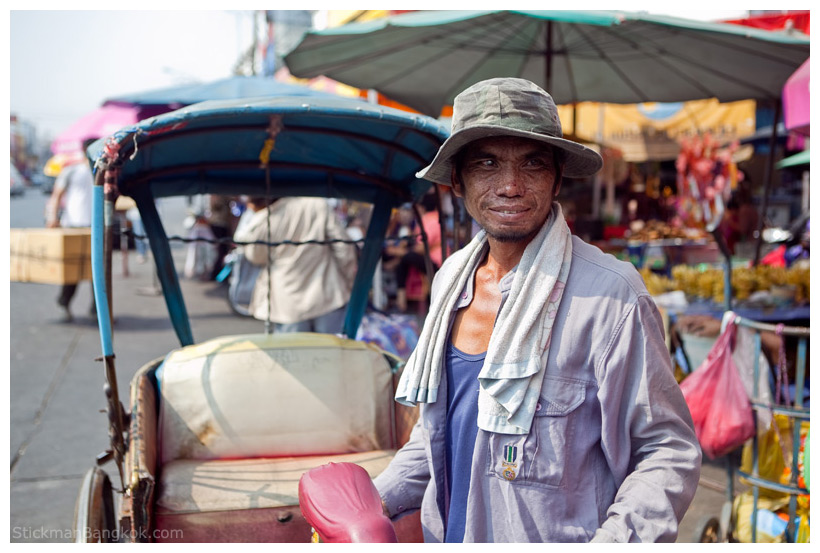
The people of Isaan are, in my opinion, the friendliest people that I have met. I have never met so many truly wonderfully warm people and I continue to return to this region just to enjoy the warmth of the people and their remarkable hospitality. The ladies in the above photo (taken at the central market in Korat) are just one example of how these people continue to smile and enjoy life despite the curve balls that life in the poor, rural areas of Thailand continues to throw at them. If you really want to see the genuine, traditional Thailand, then Isaan is arguable the best place to go. Try and go with someone who speaks reasonable Thai and has either lived in Thailand for a while or has been there a few times and that way you will likely have a far more enjoyable experience.
I don't know if it is good luck or what, but whenever I have been in Isaan, the sun shines strong and days are generally cloudless. This gives great opportunity for taking photos and the good weather helps to keep a smile on your face. Obviously if you go in the middle of the rainy season, it won't be like this though!
It is possible however that you will find Isaan boring. Let's be straight about this as it is quite different from all of the popular places to go in Thailand. Isaan is for those who genuinely want to taste a traditional rural slice of Thailand. I have taken a few people up there and some have admitted to me that it was less then enthralling. But those who genuinely love Thailand and the Thai people and who really are interested to know what the real Thailand is like, this is the place for you. Also, to get the most out of it, speaking Thai to a high level really does make a difference. A lot o the rural people speak little to no English so the inability to communicate does reduce your chances of doing anything more than functional conversation, ordering food, specifying how many nights you want to stay in a hotel etc.
The food in Isaan is known for being particularly spicy, and a lot of the dishes from the Isaan region also contain bla-ra, that is fermented fish sauce, something which most Westerners and indeed most Thais not from the region do not really care for. A typical Isaan meal would consist of a number of dishes from region and be accompanied by sticky rice, which is rolled into balls with the fingers. Typical dishes of Isaan are larb (a spicy salad, usually with some sort of diced meat such as pork, beef, chicken or duck). Other popular dishes are gai yarng (grilled chicken), nam dok (a spicy salad where the meat is cut into larger pieces rather than diced) and the ubiquitous som tum (papaya salad). This last dish is popular Thailand wide, but it is generally agreed that the best som tum, pictured below, comes from the Isaan region.
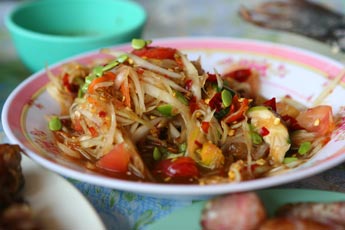
I have always felt some of the best, tourist friendly places to try Isaan food are some of the venues on the Mekhong up in Nongkhai. It is a quite delightful setting, sitting there, overlooking the mighty Mekhong and looking across at Laos, which itself is famous for its own cuisine, much of it very similar to Isaan food, and said to be even hotter!
Korat
Korat, also known as Nakhon Rachasima, is located 250 km northeast of Bangkok and if you travel to the Isaan region by car, bus, or train, it is the first province you will reach.
Korat is also the largest province in Thailand with a population of about 6 million, although like many of Isaan’s province, many of these people live and work outside of the province.
Downtown Korat really doesn’t have much in the way of tourist attractions. The city square in the heart of downtown is home to the Ya Mo statue and is a revered image for locals of Korat who will visit the statue and make a wish. You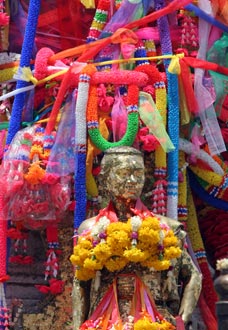 could spend an hour or two wandering around this area, getting a feel for the area, but I think any longer than that and one may start to get bored. There is a large market nearby which is interesting if you have not seen any fresh markets in Thailand, and Korat is also home to the largest shopping centre in the Isaan region, called The Mall. There you’ll find branches of all of the usual Thai chain stores and American fast food restaurants. It is of no real interest if you have jut come from, or are about to go to, Bangkok.
could spend an hour or two wandering around this area, getting a feel for the area, but I think any longer than that and one may start to get bored. There is a large market nearby which is interesting if you have not seen any fresh markets in Thailand, and Korat is also home to the largest shopping centre in the Isaan region, called The Mall. There you’ll find branches of all of the usual Thai chain stores and American fast food restaurants. It is of no real interest if you have jut come from, or are about to go to, Bangkok.
There are many temples in downtown Korat but frankly, if you have seen a few Thai temples already then none are particularly impressive nor worth going out of your way for.
There are a handful of very small hangouts in Korat where the local expat population hangs out. There is a piazza shop and a Lebanese restaurant right next to each other – the Lebanese restaurant in particular has very good, inexpensive food. It also has a large screen TV with cable so if you ever want to watch a major sports event that is the place to go. In another part of town is Bule’s Saloon, German owned restaurant with German and other Western food. I have eaten there a couple of times and it is ok. Many of the Westerners resident in Korat are older, and I get the feeling that the very slow pace of life in the city suits them well.
There are a number of very reasonable hotels in Korat for around, or a little over, 1,000 baht a night, which gets you a comfortable room and a buffet breakfast. At the bottom end of the accommodation market, some of the rooms for just a few hundred baht are a bit average, so if you are on a budget make sure you check out the room before handing over your hard earned! I would not recommend spending any more than one night in Korat as there is not a lot to do. Even the nightlife is a bit sleepy.
The most impressive attraction in Korat is not in downtown Korat, but 50km north up the main highway in Phimai. There you can find some very well preserved old Khmer temple ruin, and in some ways the Phimai Historical Park reminds me of a very small version of Angkor Wat. This is well worth checking out, in fact the little town of Phimai is a pretty place with some nice parks and is worth spending and hour or two wandering around. Buses leave Korat for Phimai frequently.
Khon Kaen
200 km up the main highway from Korat is Khon Kaen, the place I have always considered the heart of Isaan. This is where you find the best university in Isaan, as well as what I believe is the best hospital.
Like Korat, Khon Kaen is hardly a pretty place, and neither is there a great deal to do there, either in the provincial capital, or outside it for that matter. However, I have always enjoyed visiting Kohn Kaen and have found the people in the town to be very friendly and it is easy to meet up with people to hang out with.
To me, the only place worth checking out in Khon Kaen is the 9 level temple which is a couple of kilometres south of the city centre. It is an unusual design and is rather attractive. There's a pleasant lake nearby surrounded by a park where you can stretch your legs.
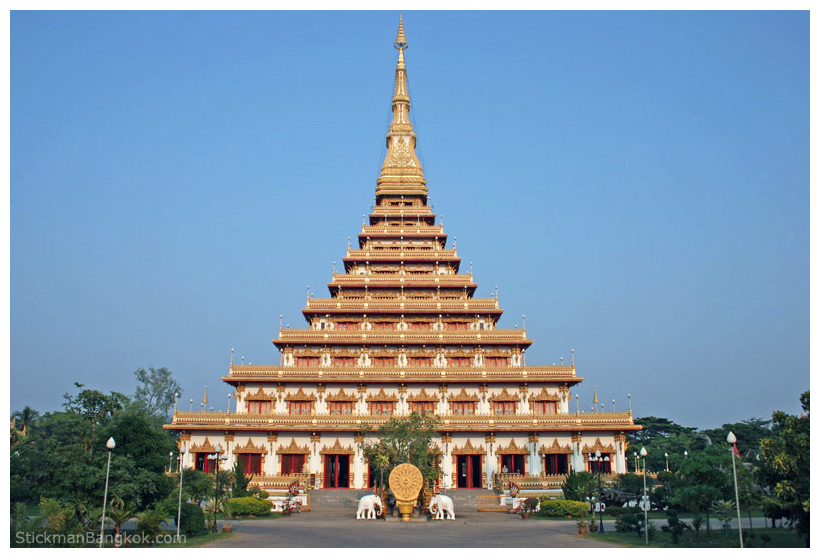
Khon Kaen has a more vibrant nightlife than Korat. There are a few bars where local farangs meet, and in a lane close to the Pullman Hotel are many discos and bars. The locals are friendly and while the sight of a farang I not completely unusual in Khon Kaen, the locals are till curious enough about us that they may well approach you and try to find out more about you.
The Charoen Thani Princess Hotel in the centre of the city provides excellent rooms at a mere 1,100 baht a night and is where I always stay when I am in Khon Kaen.
Udon Thani
Another 100 or so kilometres up the road from Khon Kaen is Udon Thani, a smaller provincial capital which has proven to be popular with Westerners in recent years and even has a thriving farang bar scene. There are probably more farang oriented bars and restaurants in the city of Udon than in any other centre in Isaan, and this is no doubt due to the high number of girls from Udon who work in Bangkok and Pattaya where they meet a Westerner, get married, and then they both go and live happily ever after in the Thai countryside. Udon is said to have both the highest number of Westerners in Isaan, as well as the highest percentage of Westerners for a province in Isaan.
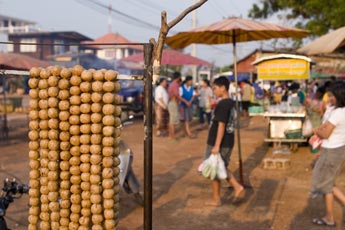
Sai-grok Isaan, Isaan sausages, for sale in a market.
The city of Udon doesn't have any major tourist attractions, or at least none that I am aware of. The provinces attractions are well outside the provincial capital and include national parks and Ban Chiang, a site where a lot of old fossils and relics were found and a spot said to be of archaeological significance. A friend who has visited was not that impressed but that said, I have not been there myself.
In downtown Udon there is a large shopping centre with a greater vibrancy than any of the other shopping centres in the major centres of Udon. Here you will see far more Westerners than anywhere else in Isaan, some are tourists and some are locally based. I guess most make it to Udon with their teeruk.
Across the road from the shopping centre and behind a row of shops is a strip of beer bars, a la Pattaya, that frankly I am surprised are allowed to operate. Directly opposite the shopping centre are a handful of bars, Differen Bar (Yes, that is how it is spelt), Tong's Bar and Barberry. Barberry has women available for the naughty boys and Differen Bar had coyote dancers, at least the last time I was there, in early 2007.
This shopping centre is where many of the more well to do Udonites venture at the weekend and I cannot imagine what they think of establishments opening that target farangs directly, bars and restaurants.
Food in Udon Thani is very good. Westerners rave about the Irish Clock, a small Irish bar which I have yet to try. There is also a very, very good Italian restaurant called Roma Piccolo which is superb. It is located a bit outside the city centre, out on the road past Big C. It is well worth going out of your way for!
On thing I will say about Udon is that the people are very friendly, and the farangs who live in the province, both in the provincial capital, and in some of the surrounding districts, most seem to be fairly happy and in no hurry to up and go elsewhere. As far as actual interesting tourist spots go, Udon is not really famous for a lot. There is Ban Chiang, museum of some pottery remains and relics found in the area that apparently date back to prehistoric times, and there is Phu Foi Lom, a pleasant park atop a hill. Apart from that, I personally have not seen a lot of any great interest in Udon, but that said, like most of Udon, the thrill is in the vibe, and interacting with the people, as opposed to the actual tourist sites themselves.
Nongkhai
About 50 kilometres or so up the road from Udon Thani is the pretty city of Nongkhai which sits on the banks of the Mekhong River overlooking Laos. The city is a little non-descript but the people are very nice and there are a number of very pleasant restaurants on the banks of the river looking across at Laos.
A little outside the city is Sala Gowgoo, one of my favourite tourist attractions in all of Thailand. It is what I could best term a Buddhist statue park where you have a large number of concrete Buddha images. Amazingly, there is just a 10 baht entrance fee. It is a little outside the city so you'll have to get a songtaew to take you if you do not have your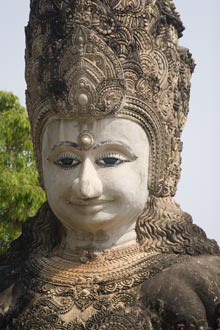 own transport but this really is a must see location. I find it all very fascinating and it is all the better if you can take a Thai along with you to translate some of the story that is told across the statues. If you go to Nongkhai and do not visit Sala Gowgoo then you really have missed out on something rather special!
own transport but this really is a must see location. I find it all very fascinating and it is all the better if you can take a Thai along with you to translate some of the story that is told across the statues. If you go to Nongkhai and do not visit Sala Gowgoo then you really have missed out on something rather special!
Nongkhai has a solid stream of foreigners passing through every day, especially the backpacker variety, who are usually on their way to or from Laos. Nongkhai is a charming little town which is well worth a day of your time. Like so many of the towns in Thailand that have a river running through it, Nongkhai has many excellent restaurants on the edge of the banks of the river, looking across the Mekong River at Thailand's nicest neighbour, Laos. Although these restaurants do target foreigners, the costs are still very reasonable and the ambience at some of them is just wonderful. Imagine kicking back in a riverside restaurant looking across the Mekong River as the sun sets over Laos. A typically cool Isaan evening, swigging back your choice of poison, and nodding your head at some rugged looking, toothless local who has been telling you a story for the last half hour that has yet to include one word you understand. He smiles, you smile and everyone is happy!
Nongkhai has developed a lot in the last decade. I visited in 1998 and then again 2007, and the differences were huge. The whole riverfront area has been developed into a pleasant spot with Thai style salas (pavilions) where you can sit and relax in the shade and enjoy the view across to Laos. There is now a great number of guesthouses right in the riverfront area and the rates are more than affordable. From what I saw from signs posted, air-con rooms could be had for less than 500 baht per night, a very good deal indeed. And there are a heap of new riverside restaurants, the sort of venues that I never bore of. If you find yourself in Nongkhai, it is definitely worth staying a night, and if you want to chill out, stay for a few! The downside about Nongkhai is that it is a sleepy little town and there is little to do after dark.
Roi Et
Roi Et, meaning one hundred and one, is one of my favourite spots in all of Isaan. The city is very pretty with a lake in the centre, of which there is an island in the centre of the lake. The people are nice and the city is home to many temples, all of which are walkable.
Roi Et has the tallest Buddha image in Thailand at approximately 65 metres in height and it towers over the city.
The first time I went to Roi Et the I had only planned to stay one night but I liked it so much I stayed two!
There are a small number of Westerners resident in the Roi Et area so there are at least a couple of Western oriented restaurants including the White Elephant which is just over the canal from the Roi Et City Hotel as well as a pizza shop which overlooks the lake and is the de facto meeting place for Westerners living in the area.
Truth be told, as pleasant as Roi Et is, unless you really like the Isaan region, you may find it boring. There are a lot of temples in the city, and it is pretty, but there is little to do. Like many of the "smaller" provincial capitals in Isaan everything closes down early and come 9 PM the city can feel like a bit of a ghost town!
There is a bar area just outside the city moat. Ask any tuktuk driver to take you to "rong bier" and they will know the place. In the area are a number of Thai style venues where very cheap alcohol can be had. To give you an idea of just ho cheap it is, even in 2010 large bottles of Singha beer in one of the entertainment venues were running around 80 baht…which is only about 20 baht more than you would pay in a 7 Eleven store!
Nakhon Phanom
The city of Nakhon Phanom is one of the farthest flung cities in Isaan if you are coming from Bangkok and is approximately 700 km from the capital.
The city itself does not have any specific attractions to draw Western tourists other than that it is simply a very nice spot, on the banks of the Mekhong River with very nice views across to Laos. The city itself is clean and there is a very nice river front area where people hang out and jog in the late afternoon.
About 55 km south of the city is the most revered of all of the Buddhist temples in Isaan. That Phanom is a large, beautiful Buddhist temple of which the style reminds me of many temples I have seen in Laos. 55 kilometres might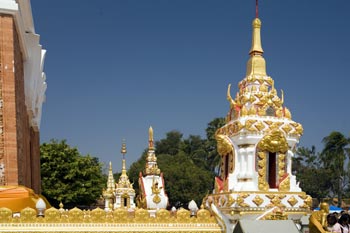 sound like a long way, but it is well worth going out of your way to check out. I am not sure what local transport is available but imagine that there must be buses running between Nakhon Phanom and That Phanom. You could always get a bus to Mukdahan, the province on the Mekhong immediately to the south, as I imagine they must run through That Phanom.
sound like a long way, but it is well worth going out of your way to check out. I am not sure what local transport is available but imagine that there must be buses running between Nakhon Phanom and That Phanom. You could always get a bus to Mukdahan, the province on the Mekhong immediately to the south, as I imagine they must run through That Phanom.
There didn’t seem to be anything in the way of bars or restaurants specifically for the small number of Westerners in the area although there is a bar area not far from the river front. BarKoo was the most popular of the bars that are all within a stone’s throw of each other. These bars server good food at very reasonable prices in addition to the Tex Italia restaurant in the little square which serves Thai versions of some favourite Western dishes.